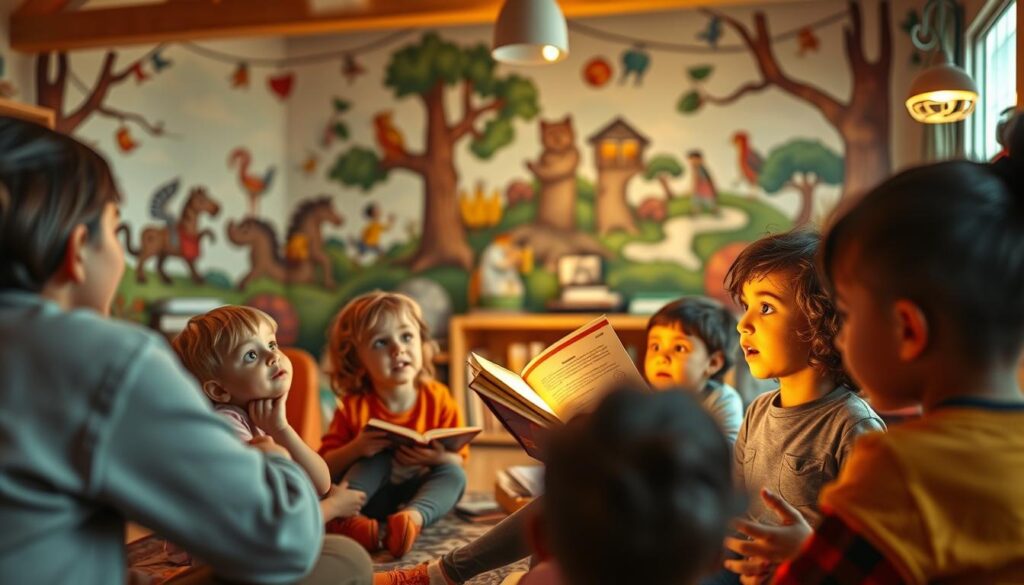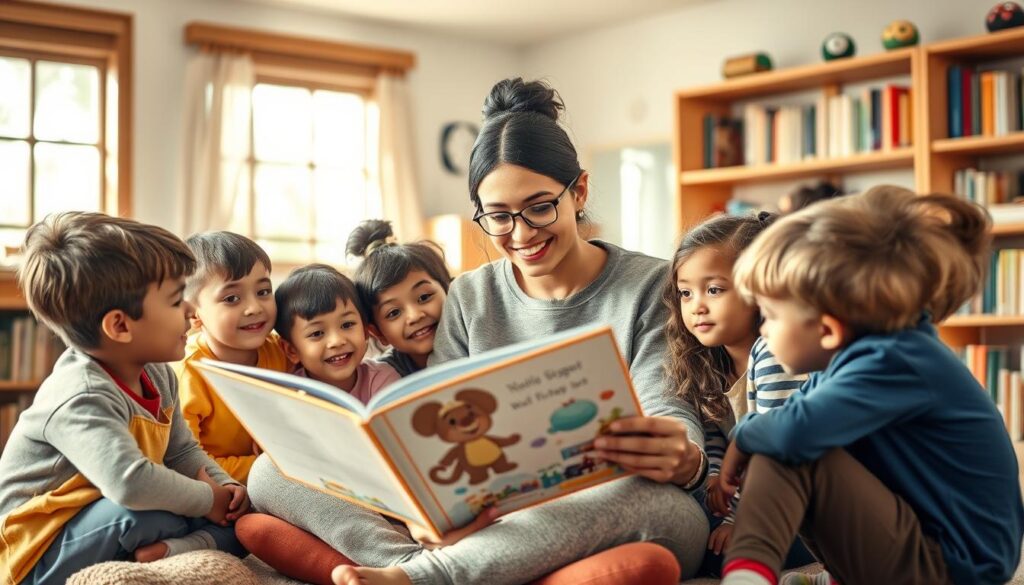Have you ever wondered how to spark a love for learning in your child’s mind?
The art of storytelling has been a timeless method for passing down knowledge and wisdom. By using stories as a teaching tool, we can capture a child’s imagination and foster a deep understanding of the world around them.
At the heart of our approach is the belief that education should be a journey of discovery, not just a transfer of information. By leveraging the power of stories, we can create a way for children to engage with complex concepts in a simple, yet meaningful manner, cultivating their natural curiosity.
The Power of Storytelling in Early Childhood Development
In the realm of early childhood education, storytelling emerges as a potent force, capable of transforming the learning experience into an engaging and relatable journey. Storytelling is one of the oldest forms of communication, used to share experiences, understand others, and entertain. It can also be a powerful learning tool, especially in early childhood education.
Stories have the ability to connect young learners to the content in a more relatable way. They’re also a fun, engaging approach to learning that requires little more than a good narrative linked to your objectives.
How Stories Shape Young Minds
When children engage with stories, their brains light up in ways that simple instruction cannot match. Multiple neural pathways activate, creating stronger memory imprints and deeper understanding. This is because young minds are naturally wired to process narrative structures, making storytelling one of the most developmentally appropriate teaching methods for early childhood education.
The Ancient Art of Narrative in Modern Education
Stories have been humanity’s primary vehicle for transmitting knowledge since before written language existed. This ancient power is now being harnessed in modern educational settings with remarkable results. Research shows that information delivered through storytelling is retained up to 22 times more effectively than facts presented in isolation.
| Benefits of Storytelling | Description |
|---|---|
| Enhanced Retention | Information is retained up to 22 times more effectively |
| Develops Crucial Skills | Listening comprehension, vocabulary acquisition, and pattern recognition |
| Engages Imagination | Provides a counterbalance to passive screen time |
By incorporating storytelling into early childhood education, we can create a more engaging, effective, and enjoyable learning experience. As we continue to explore the power of storytelling, it’s clear that this ancient art holds significant potential for shaping young minds and fostering a love for learning.
Understanding Lunesia’s Storytelling Philosophy
At Lunesia, our approach to storytelling is centered around creating an immersive experience for children. We believe that interactive narratives are key to engaging young minds and fostering a love for learning.
Interactive Narratives That Engage Children
Our stories are designed to be interactive, allowing children to make choices that influence the direction of the narrative. This approach not only respects their autonomy but also builds decision-making skills. By visiting Lunesia.app, parents can access a wealth of interactive stories that let their children help shape the tale.

Child-Led Adventures and Personalized Learning
Lunesia’s storytelling philosophy is built around the idea that children learn best when they’re active participants in their educational journey. Our child-led adventures are carefully crafted to respond to children’s natural curiosity, encouraging questions and exploration. Parents have reported that these adventures not only keep their children engaged but also spark meaningful conversations long after the story ends.
By incorporating gentle pauses and reflection moments within our stories, we give children the time they need to absorb information and form their own connections, promoting deep learning and a love for stories that extends beyond the initial telling.
How Lunesia Storytelling Nurtures Curiosity and Learning
Lunesia’s storytelling methodology is built on the principle that curiosity is the engine of learning. By designing our stories to fuel this natural drive in children, we encourage them to explore, discover, and learn at their own pace.
Creating Safe Spaces for Exploration
Our stories create psychological safety by addressing common childhood fears within the protective framework of narrative. This allows children to explore challenging emotions from a comfortable distance. For instance, “Ocean’s Whisper” reimagines water as a gentle, magical friend, turning anxiety into a captivating experience of discovery and calm.
Turning Fears into Learning Opportunities
We transform fears into learning opportunities through empowering tales like Leo’s Dreamland Quest, which shows kids how to take control of their dreams and turn fear into creativity. By presenting puzzles within the narrative, our stories invite children to develop their own theories and solutions, fostering a growth mindset and teaching them that challenges are interesting puzzles to solve.
Cognitive Benefits of Narrative-Based Learning
The cognitive benefits of narrative-based learning are multifaceted, impacting young minds in profound ways. Storytelling has a number of noted brain benefits in young students, stimulating their imagination, boosting memory skills, and laying a foundation for more complex cognitive processes.
By engaging with Lunesia stories, students exercise crucial memory skills as they follow plot sequences and remember character details. Research shows that information embedded in narrative structures is remembered approximately 22 times more effectively than facts presented in isolation. You can explore more about narrative-based learning and its benefits on our platform, which offers a range of interactive stories and learning tools, similar to those found in apps like Lunesia.
Enhancing Memory and Comprehension Skills
Narrative-based learning enhances memory and comprehension skills by providing children with mental frameworks to organize new information. The predictable structure of stories, with a beginning, middle, and end, helps children understand and retain information more effectively.
| Cognitive Skill | Benefit of Narrative-Based Learning |
|---|---|
| Memory | Improved retention of information through story sequences |
| Comprehension | Better understanding of complex concepts through narrative examples |
Building Critical Thinking Through Story Structure
Critical thinking is developed through exposure to story structures that incorporate cause-and-effect relationships, encouraging children to predict outcomes and understand consequences. Lunesia stories deliberately build logical thinking skills, fostering critical thinking in young learners.

Emotional Intelligence Through Character-Driven Stories
Character-driven stories have the power to transform children’s emotional landscapes. By exploring complex emotions and social dynamics through narratives, we can support students’ emotional intelligence and foster a deeper understanding of themselves and others.
Developing Empathy and Understanding
Through character-driven stories, children can develop empathy by connecting with characters like Luma the lantern or Rosie facing a new school. This safe and guided practice translates to real-world social interactions, helping children build stronger relationships with their peers.
Building Resilience Through Narrative Challenges
By featuring characters who face setbacks but persevere, Lunesia stories help children develop resilience. This narrative approach allows children to rehearse mentally how to bounce back from difficulties before encountering them in real life, promoting a growth mindset and emotional well-being.
Cultural Awareness and Diverse Perspectives in Lunesia Stories
Lunesia’s approach to storytelling is deeply rooted in promoting cultural awareness and diverse perspectives. By incorporating diverse characters, settings, and traditions into our narratives, we aim to introduce children to new cultures and ways of life.
Broadening Horizons Through Diverse Narratives
Our stories serve as cultural bridges, gently introducing children to different ways of living, celebrating, and problem-solving across various communities. We carefully research and respectfully represent cultural elements, ensuring authenticity and avoiding stereotypes.
Fostering a Culture of Respect and Understanding
By normalizing diversity within our stories, we help children develop a worldview where human variation is expected and valued. This approach fosters empathy, respect, and appreciation for differences, preparing young learners for life in a multicultural society.
| Benefits of Diverse Stories | Impact on Children |
|---|---|
| Exposure to different cultures | Fosters empathy and understanding |
| Representation of diverse traditions | Promotes respect for differences |
| Collaborative problem-solving | Encourages teamwork and inclusivity |
By incorporating diverse perspectives and cultures into our stories, we help children develop a more nuanced understanding of the world. This, in turn, prepares them to thrive in an increasingly interconnected society.
Practical Applications: Incorporating Lunesia Stories at Home
You can easily bring Lunesia stories into your home, making storytelling a natural part of your family’s daily rhythm. By doing so, you create a nurturing environment that fosters curiosity and a love for learning in your child.
Creating Meaningful Bedtime Routines
Establishing a consistent storytelling routine is key. Bedtime offers a perfect opportunity for this, as children’s minds are receptive and the intimate setting enhances emotional connection. For example, you can use stories like “The Little Lantern Who Wanted to Shine” to help your child relax and feel safe.
Extending Story Themes into Daily Activities
To maximize the impact of Lunesia stories, gently reference them during relevant daily moments. For instance, if a character in the story faced a challenge, you can say, “Remember how Marina was nervous about the water? Let’s try that approach at the pool today.” This reinforces learning and helps your child apply the lessons to real-life situations.
| Activity | Lunesia Story Connection | Learning Outcome |
|---|---|---|
| Bedtime Storytelling | “The Little Lantern Who Wanted to Shine” | Relaxation, Feeling Safe |
| Pool Visit | Marina’s Story | Overcoming Fears |
| Playtime | Using Props Related to Story Themes | Creative Thinking, Comprehension |
Conclusion: Nurturing Lifelong Learners Through the Magic of Stories
As we conclude our exploration of Lunesia’s storytelling approach, it’s clear that the impact goes far beyond mere entertainment. Lunesia storytelling lays the foundation for children to become curious, compassionate, and confident lifelong learners.
The neural pathways formed through narrative engagement in early childhood create lasting cognitive frameworks that support learning across all subjects and throughout life. When children experience the joy of discovery through stories, they develop an intrinsic motivation to learn that’s far more powerful and enduring than external rewards or pressure.
By incorporating Lunesia stories into family routines, parents are not just creating lovely memories—they’re actively building their children’s resilience, empathy, and problem-solving capabilities. I invite you to begin or deepen your family’s storytelling journey today, knowing that each narrative moment is building your child’s capacity for curiosity, understanding, and lifelong learning.
FAQ
How can narrative-based education help my child develop critical thinking skills?
By using stories with complex characters and plot twists, you can help your child build critical thinking skills. This type of narrative encourages children to analyze situations, make informed decisions, and think creatively.
What are some ways to incorporate diverse perspectives and cultures into my child’s storytime?
You can introduce diverse stories that reflect different cultures, traditions, and lifestyles. This exposure helps children develop empathy and understanding, fostering a more open-minded and respectful attitude towards others.
How can I use bedtime stories to create a meaningful routine for my child?
Establish a calming pre-sleep routine that includes reading together. Choose stories that promote relaxation and spark imagination, making bedtime a special bonding experience.
Can narrative-based learning really help my child overcome their fears?
Yes, stories can be a powerful tool in helping children confront and manage their fears. By exploring different scenarios and outcomes through narratives, children can develop resilience and learn to cope with challenging emotions.
How do interactive narratives engage children in the education process?
Interactive stories encourage children to participate actively, making choices and decisions that impact the narrative. This engagement fosters a deeper connection to the story, promoting a love for education and exploration.
What are the benefits of using character-driven stories to teach emotional intelligence?
Character-driven stories help children understand different emotions, motivations, and relationships. By exploring complex characters, children develop empathy and a deeper understanding of themselves and others.




